1. Cyclone IV Device Datasheet
March 2016
CYIV-53001-2.0
CYIV-53001-2.0
This chapter describes the electrical and switching characteristics for Cyclone IV
devices. Electrical characteristics include operating conditions and power
consumption. Switching characteristics include transceiver specifications, core, and
periphery performance. This chapter also describes I/O timing, including
programmable I/O element (IOE) delay and programmable output buffer delay.
This chapter includes the following sections:
■ “Operating Conditions” on page 1–1
■ “Power Consumption” on page 1–16
■ “Switching Characteristics” on page 1–16
■ “I/O Timing” on page 1–37
■ “Glossary” on page 1–37
Operating Conditions
When Cyclone IV devices are implemented in a system, they are rated according to a
set of defined parameters. To maintain the highest possible performance and
reliability of Cyclone IV devices, you must consider the operating requirements
described in this chapter.
Cyclone IV devices are offered in commercial, industrial, extended industrial and,
automotive grades. Cyclone IV E devices offer –6 (fastest), –7, –8, –8L, and –9L speed
grades for commercial devices, –8L speed grades for industrial devices, and –7 speed
grade for extended industrial and automotive devices. Cyclone IV GX devices offer
–6 (fastest), –7, and –8 speed grades for commercial devices and –7 speed grade for
industrial devices.
f For more information about the supported speed grades for respective Cyclone IV
devices, refer to the Cyclone IV FPGA Device Family Overview chapter.
1 Cyclone IV E devices are offered in core voltages of 1.0 and 1.2 V. Cyclone IV E
devices with a core voltage of 1.0 V have an ‘L’ prefix attached to the speed grade.
In this chapter, a prefix associated with the operating temperature range is attached to
the speed grades; commercial with a “C” prefix, industrial with an “I” prefix, and
automotive with an “A” prefix. Therefore, commercial devices are indicated as C6, C7,
C8, C8L, or C9L per respective speed grade. Industrial devices are indicated as I7, I8,
or I8L. Automotive devices are indicated as A7.
© 2016 Altera Corporation. All rights reserved. ALTERA, ARRIA, CYCLONE, HARDCOPY, MAX, MEGACORE, NIOS, QUARTUS and STRATIX words and logos
are trademarks of Altera Corporation and registered in the U.S. Patent and Trademark Office and in other countries. All other words and logos identified as
trademarks or service marks are the property of their respective holders as described at www.altera.com/common/legal.html. Altera warrants performance of its
semiconductor products to current specifications in accordance with Altera's standard warranty, but reserves the right to make changes to any products and
services at any time without notice. Altera assumes no responsibility or liability arising out of the application or use of any information, product, or service
described herein except as expressly agreed to in writing by Altera. Altera customers are advised to obtain the latest version of device specifications before relying
on any published information and before placing orders for products or services.
ISO
9001:2008
Registered
Cyclone IV Device Handbook,
Volume 3
March 2016
Feedback Subscribe
�
1–2
Chapter 1: Cyclone IV Device Datasheet
Operating Conditions
1 Cyclone IV E industrial devices I7 are offered with extended operating temperature
range.
Absolute Maximum Ratings
Absolute maximum ratings define the maximum operating conditions for Cyclone IV
devices. The values are based on experiments conducted with the device and
theoretical modeling of breakdown and damage mechanisms. The functional
operation of the device is not implied at these conditions. Table 1–1 lists the absolute
maximum ratings for Cyclone IV devices.
c Conditions beyond those listed in Table 1–1 cause permanent damage to the device.
Additionally, device operation at the absolute maximum ratings for extended periods
of time have adverse effects on the device.
Table 1–1. Absolute Maximum Ratings for Cyclone IV Devices (1)
Min
–0.5
–0.5
–0.5
–0.5
–0.5
–0.5
–0.5
Max
1.8
3.75
1.8
3.75
4.5
3.75
3.75
Unit
V
V
V
V
V
V
V
Symbol
VCCINT
VCCA
VCCD_PLL
VCCIO
VCC_CLKIN
VCCH_GXB
VCCA_GXB
Parameter
Core voltage, PCI Express (PCIe) hard IP
block, and transceiver physical coding sublayer
(PCS) power supply
Phase-locked loop (PLL) analog power supply
PLL digital power supply
I/O banks power supply
Differential clock input pins power supply
Transceiver output buffer power supply
Transceiver physical medium attachment (PMA)
and auxiliary power supply
Transceiver PMA and auxiliary power supply
DC input voltage
DC output current, per pin
Storage temperature
Operating junction temperature
power supply.
VCCL_GXB
VI
IOUT
TSTG
TJ
Note to Table 1–1:
(1) Supply voltage specifications apply to voltage readings taken at the device pins with respect to ground, not at the
–0.5
–0.5
–25
–65
–40
1.8
4.2
40
150
125
V
V
mA
°C
°C
Maximum Allowed Overshoot or Undershoot Voltage
During transitions, input signals may overshoot to the voltage shown in Table 1–2 and
undershoot to –2.0 V for a magnitude of currents less than 100 mA and for periods
shorter than 20 ns. Table 1–2 lists the maximum allowed input overshoot voltage and
the duration of the overshoot voltage as a percentage over the lifetime of the device.
The maximum allowed overshoot duration is specified as a percentage of high-time
over the lifetime of the device.
Cyclone IV Device Handbook,
Volume 3
March 2016 Altera Corporation
�
Chapter 1: Cyclone IV Device Datasheet
Operating Conditions
1–3
1 A DC signal is equivalent to 100% duty cycle. For example, a signal that overshoots to
4.3 V can only be at 4.3 V for 65% over the lifetime of the device; for a device lifetime
of 10 years, this amounts to 65/10ths of a year.
Table 1–2. Maximum Allowed Overshoot During Transitions over a 10-Year Time Frame for
Cyclone IV Devices
Symbol
Parameter
Condition (V)
Overshoot Duration as % of High Time
Vi
AC Input
Voltage
VI = 4.20
VI = 4.25
VI = 4.30
VI = 4.35
VI = 4.40
VI = 4.45
VI = 4.50
VI = 4.55
VI = 4.60
100
98
65
43
29
20
13
9
6
Unit
%
%
%
%
%
%
%
%
%
Figure 1–1 shows the methodology to determine the overshoot duration. The
overshoot voltage is shown in red and is present on the input pin of the Cyclone IV
device at over 4.3 V but below 4.4 V. From Table 1–2, for an overshoot of 4.3 V, the
percentage of high time for the overshoot can be as high as 65% over a 10-year period.
Percentage of high time is calculated as ([delta T]/T) × 100. This 10-year period
assumes that the device is always turned on with 100% I/O toggle rate and 50% duty
cycle signal. For lower I/O toggle rates and situations in which the device is in an idle
state, lifetimes are increased.
Figure 1–1. Cyclone IV Devices Overshoot Duration
4.4 V
4.3 V
3.3 V
DT
T
March 2016 Altera Corporation
Cyclone IV Device Handbook,
Volume 3
�
1–4
Chapter 1: Cyclone IV Device Datasheet
Operating Conditions
Recommended Operating Conditions
This section lists the functional operation limits for AC and DC parameters for
Cyclone IV devices. Table 1–3 and Table 1–4 list the steady-state voltage and current
values expected from Cyclone IV E and Cyclone IV GX devices. All supplies must be
strictly monotonic without plateaus.
Table 1–3. Recommended Operating Conditions for Cyclone IV E Devices (1), (2) (Part 1 of 2)
Symbol
Parameter
Conditions
VCCINT (3)
VCCIO (3), (4)
VCCA
(3)
VCCD_PLL (3)
VI
VO
TJ
Supply voltage for internal logic,
1.2-V operation
Supply voltage for internal logic,
1.0-V operation
Supply voltage for output buffers,
3.3-V operation
Supply voltage for output buffers,
3.0-V operation
Supply voltage for output buffers,
2.5-V operation
Supply voltage for output buffers,
1.8-V operation
Supply voltage for output buffers,
1.5-V operation
Supply voltage for output buffers,
1.2-V operation
Supply (analog) voltage for PLL
regulator
Supply (digital) voltage for PLL,
1.2-V operation
Supply (digital) voltage for PLL,
1.0-V operation
Input voltage
Output voltage
Operating junction temperature
tRAMP
Power supply ramp time
—
—
—
—
—
—
—
—
—
—
—
—
—
For commercial use
For industrial use
For extended temperature
For automotive use
Standard power-on reset
(POR) (5)
Fast POR (6)
Min
1.15
0.97
3.135
2.85
2.375
1.71
1.425
1.14
2.375
1.15
0.97
–0.5
0
0
–40
–40
–40
50 µs
50 µs
Typ
1.2
1.0
3.3
3
2.5
1.8
1.5
1.2
2.5
1.2
1.0
—
—
—
—
—
—
—
—
Max
1.25
1.03
3.465
3.15
2.625
1.89
1.575
1.26
2.625
1.25
1.03
3.6
VCCIO
85
100
125
125
50 ms
3 ms
Unit
V
V
V
V
V
V
V
V
V
V
V
V
V
°C
°C
°C
°C
—
—
Cyclone IV Device Handbook,
Volume 3
March 2016 Altera Corporation
�
Chapter 1: Cyclone IV Device Datasheet
Operating Conditions
1–5
Table 1–3. Recommended Operating Conditions for Cyclone IV E Devices (1), (2) (Part 2 of 2)
Symbol
Parameter
IDiode
Magnitude of DC current across
PCI-clamp diode when enable
Conditions
—
Min
—
Typ
—
Max
10
Unit
mA
Notes to Table 1–3:
(1) Cyclone IV E 1.0 V core voltage devices only support C8L, C9L, and I8L speed grades. Cyclone IV E 1.2 V core voltage devices only support
C6, C7, C8, I7, and A7 speed grades.
(2) VCCIO for all I/O banks must be powered up during device operation. All VCCA pins must be powered to 2.5 V (even when PLLs are not used)
and must be powered up and powered down at the same time.
(3) VCC must rise monotonically.
(4) VCCIO powers all input buffers.
(5) The POR time for Standard POR ranges between 50 and 200 ms. Each individual power supply must reach the recommended operating range
within 50 ms.
(6) The POR time for Fast POR ranges between 3 and 9 ms. Each individual power supply must reach the recommended operating range within
3 ms.
Table 1–4. Recommended Operating Conditions for Cyclone IV GX Devices (Part 1 of 2)
Symbol
VCCINT (3)
VCCA (1), (3)
VCCD_PLL
(2)
VCCIO (3), (4)
VCC_CLKIN
(3), (5), (6)
VCCH_GXB
Parameter
Conditions
Core voltage, PCIe hard IP block, and
transceiver PCS power supply
PLL analog power supply
PLL digital power supply
I/O banks power supply for 3.3-V
operation
I/O banks power supply for 3.0-V
operation
I/O banks power supply for 2.5-V
operation
I/O banks power supply for 1.8-V
operation
I/O banks power supply for 1.5-V
operation
I/O banks power supply for 1.2-V
operation
Differential clock input pins power
supply for 3.3-V operation
Differential clock input pins power
supply for 3.0-V operation
Differential clock input pins power
supply for 2.5-V operation
Differential clock input pins power
supply for 1.8-V operation
Differential clock input pins power
supply for 1.5-V operation
Differential clock input pins power
supply for 1.2-V operation
Transceiver output buffer power supply
—
—
—
—
—
—
—
—
—
—
—
—
—
—
—
—
Min
1.16
2.375
1.16
3.135
2.85
2.375
1.71
1.425
1.14
3.135
2.85
2.375
1.71
1.425
1.14
2.375
Typ
1.2
2.5
1.2
3.3
3
2.5
1.8
1.5
1.2
3.3
3
2.5
1.8
1.5
1.2
2.5
Max
1.24
2.625
1.24
3.465
3.15
2.625
1.89
1.575
1.26
3.465
3.15
2.625
1.89
1.575
1.26
2.625
Unit
V
V
V
V
V
V
V
V
V
V
V
V
V
V
V
V
March 2016 Altera Corporation
Cyclone IV Device Handbook,
Volume 3
�
1–6
Chapter 1: Cyclone IV Device Datasheet
Operating Conditions
Table 1–4. Recommended Operating Conditions for Cyclone IV GX Devices (Part 2 of 2)
Symbol
VCCA_GXB
VCCL_GXB
VI
VO
TJ
tRAMP
IDiode
Parameter
Conditions
Transceiver PMA and auxiliary power
supply
Transceiver PMA and auxiliary power
supply
DC input voltage
DC output voltage
Operating junction temperature
Power supply ramp time
Magnitude of DC current across
PCI-clamp diode when enabled
—
—
—
—
For commercial use
For industrial use
Standard power-on reset
(POR) (7)
Fast POR (8)
—
Min
2.375
1.16
–0.5
0
0
–40
50 µs
50 µs
—
Typ
2.5
1.2
—
—
—
—
—
—
—
Max
Unit
2.625
1.24
3.6
VCCIO
85
100
50 ms
3 ms
V
V
V
V
°C
°C
—
—
10
mA
Notes to Table 1–4:
(1) All VCCA pins must be powered to 2.5 V (even when PLLs are not used) and must be powered up and powered down at the same time.
(2) You must connect VCCD_PLL to VCCINT through a decoupling capacitor and ferrite bead.
(3) Power supplies must rise monotonically.
(4) VCCIO for all I/O banks must be powered up during device operation. Configurations pins are powered up by VCCIO of I/O Banks 3, 8, and 9 where
I/O Banks 3 and 9 only support VCCIO of 1.5, 1.8, 2.5, 3.0, and 3.3 V. For fast passive parallel (FPP) configuration mode, the VCCIO level of I/O
Bank 8 must be powered up to 1.5, 1.8, 2.5, 3.0, and 3.3 V.
(5) You must set VCC_CLKIN to 2.5 V if you use CLKIN as a high-speed serial interface (HSSI) refclk or as a DIFFCLK input.
(6) The CLKIN pins in I/O Banks 3B and 8B can support single-ended I/O standard when the pins are used to clock left PLLs in non-transceiver
applications.
(7) The POR time for Standard POR ranges between 50 and 200 ms. VCCINT, VCCA, and VCCIO of I/O Banks 3, 8, and 9 must reach the recommended
operating range within 50 ms.
(8) The POR time for Fast POR ranges between 3 and 9 ms. VCCINT, VCCA, and VCCIO of I/O Banks 3, 8, and 9 must reach the recommended operating
range within 3 ms.
ESD Performance
This section lists the electrostatic discharge (ESD) voltages using the human body
model (HBM) and charged device model (CDM) for Cyclone IV devices general
purpose I/Os (GPIOs) and high-speed serial interface (HSSI) I/Os. Table 1–5 lists the
ESD for Cyclone IV devices GPIOs and HSSI I/Os.
Table 1–5. ESD for Cyclone IV Devices GPIOs and HSSI I/Os
Symbol
Parameter
Passing Voltage
VESDHBM
VESDCDM
ESD voltage using the HBM (GPIOs) (1)
ESD using the HBM (HSSI I/Os) (2)
ESD using the CDM (GPIOs)
ESD using the CDM (HSSI I/Os) (2)
Notes to Table 1–5:
(1) The passing voltage for EP4CGX15 and EP4CGX30 row I/Os is ±1000V.
(2) This value is applicable only to Cyclone IV GX devices.
± 2000
± 1000
± 500
± 250
Unit
V
V
V
V
Cyclone IV Device Handbook,
Volume 3
March 2016 Altera Corporation
�
Chapter 1: Cyclone IV Device Datasheet
Operating Conditions
DC Characteristics
1–7
This section lists the I/O leakage current, pin capacitance, on-chip termination (OCT)
tolerance, and bus hold specifications for Cyclone IV devices.
Supply Current
The device supply current requirement is the minimum current drawn from the
power supply pins that can be used as a reference for power size planning. Use the
Excel-based early power estimator (EPE) to get the supply current estimates for your
design because these currents vary greatly with the resources used. Table 1–6 lists the
I/O pin leakage current for Cyclone IV devices.
Table 1–6. I/O Pin Leakage Current for Cyclone IV Devices (1), (2)
Symbol
II
Parameter
Conditions
Device
Min
–10
–10
Typ
—
—
Max
10
Unit
A
A
IOZ
VI = 0 V to VCCIOMAX
Input pin leakage current
Tristated I/O pin leakage
current
Notes to Table 1–6:
(1) This value is specified for normal device operation. The value varies during device power-up. This applies for all VCCIO settings (3.3, 3.0, 2.5,
VO = 0 V to VCCIOMAX
—
—
10
1.8, 1.5, and 1.2 V).
(2) The 10 A I/O leakage current limit is applicable when the internal clamping diode is off. A higher current can be observed when the diode is on.
Bus Hold
The bus hold retains the last valid logic state after the source driving it either enters
the high impedance state or is removed. Each I/O pin has an option to enable bus
hold in user mode. Bus hold is always disabled in configuration mode.
Table 1–7 lists bus hold specifications for Cyclone IV devices.
Table 1–7. Bus Hold Parameter for Cyclone IV Devices (Part 1 of 2) (1)
VCCIO (V)
Parameter
Condition
1.2
1.5
1.8
2.5
3.0
3.3
Unit
Min Max Min
Max Min Max Min Max Min Max Min Max
Bus hold
low,
sustaining
current
Bus hold
high,
sustaining
current
Bus hold
low,
overdrive
current
Bus hold
high,
overdrive
current
VIN > VIL
(maximum)
VIN < VIL
(minimum)
8
—
12
—
30 — 50 — 70 — 70 — A
–8 — –12 — –30 — –50 — –70 — –70 — A
0 V < VIN < VCCIO — 125 — 175 — 200 — 300 — 500 — 500
A
0 V < VIN < VCCIO — –125 — –175 — –200 — –300 — –500 — –500
A
March 2016 Altera Corporation
Cyclone IV Device Handbook,
Volume 3
�
1–8
Chapter 1: Cyclone IV Device Datasheet
Operating Conditions
Table 1–7. Bus Hold Parameter for Cyclone IV Devices (Part 2 of 2) (1)
VCCIO (V)
Parameter
Condition
1.2
1.5
1.8
2.5
3.0
3.3
Unit
Min Max Min
Max Min Max Min Max Min Max Min Max
—
Bus hold trip
point
Note to Table 1–7:
(1) Bus hold trip points are based on the calculated input voltages from the JEDEC standard.
0.375 1.125
0.9
0.68
1.07
0.3
0.7
1.7
0.8
2
0.8
2
V
OCT Specifications
Table 1–8 lists the variation of OCT without calibration across process, temperature,
and voltage (PVT).
Table 1–8. Series OCT Without Calibration Specifications for Cyclone IV Devices
Resistance Tolerance
Description
VCCIO (V)
Commercial Maximum
Industrial, Extended
industrial, and
Automotive Maximum
Series OCT without
calibration
3.0
2.5
1.8
1.5
1.2
±30
±30
±40
±50
±50
±40
±40
±50
±50
±50
Unit
%
%
%
%
%
OCT calibration is automatically performed at device power-up for OCT-enabled
I/Os.
Table 1–9 lists the OCT calibration accuracy at device power-up.
Table 1–9. Series OCT with Calibration at Device Power-Up Specifications for Cyclone IV Devices
Calibration Accuracy
Description
VCCIO (V)
Commercial Maximum
Industrial, Extended
industrial, and
Automotive Maximum
Series OCT with
calibration at device
power-up
3.0
2.5
1.8
1.5
1.2
±10
±10
±10
±10
±10
±10
±10
±10
±10
±10
Unit
%
%
%
%
%
Cyclone IV Device Handbook,
Volume 3
March 2016 Altera Corporation
�
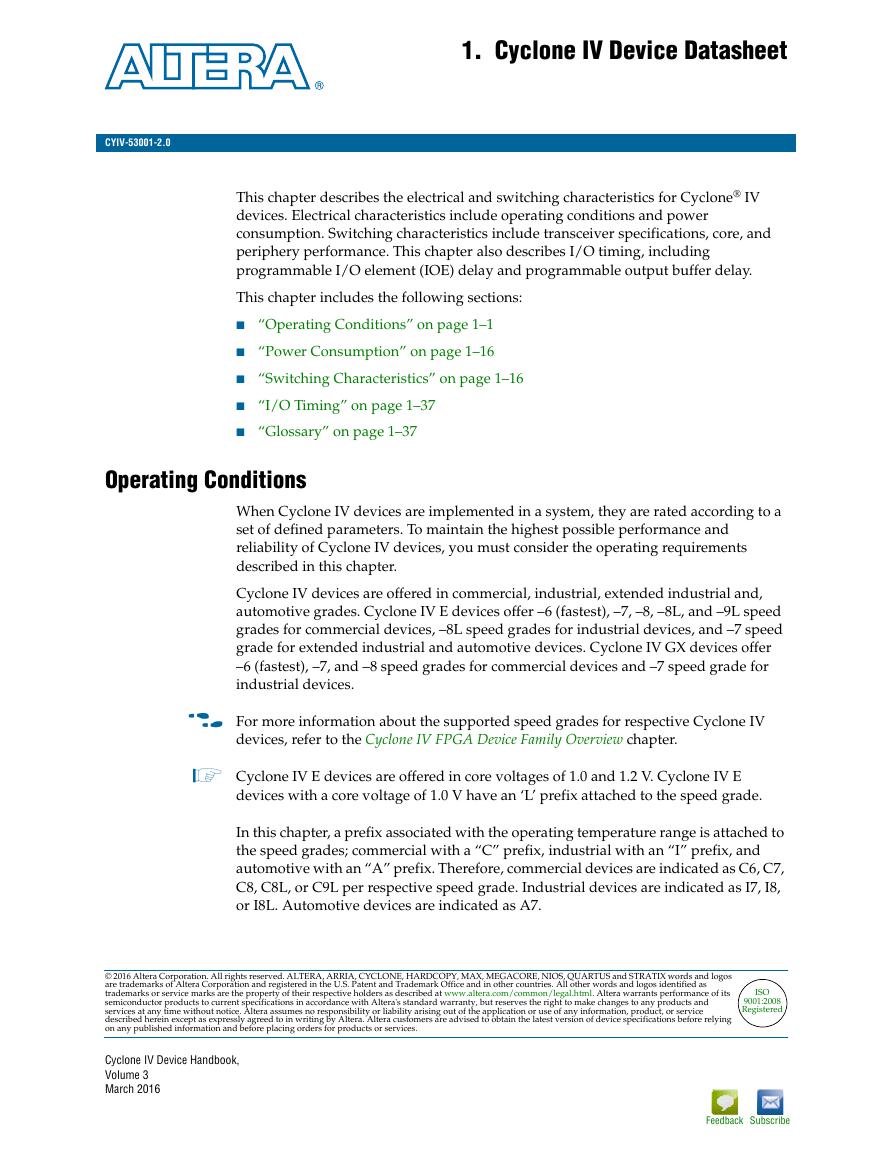
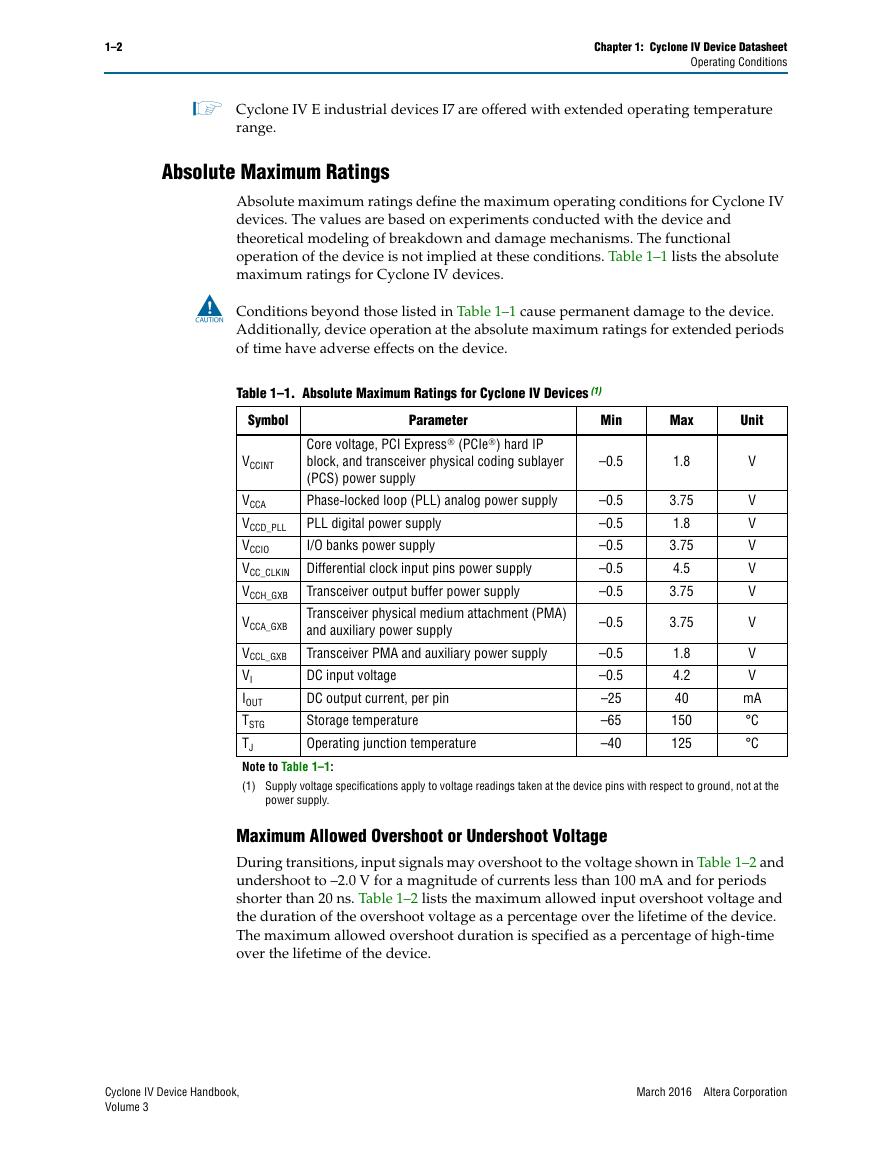
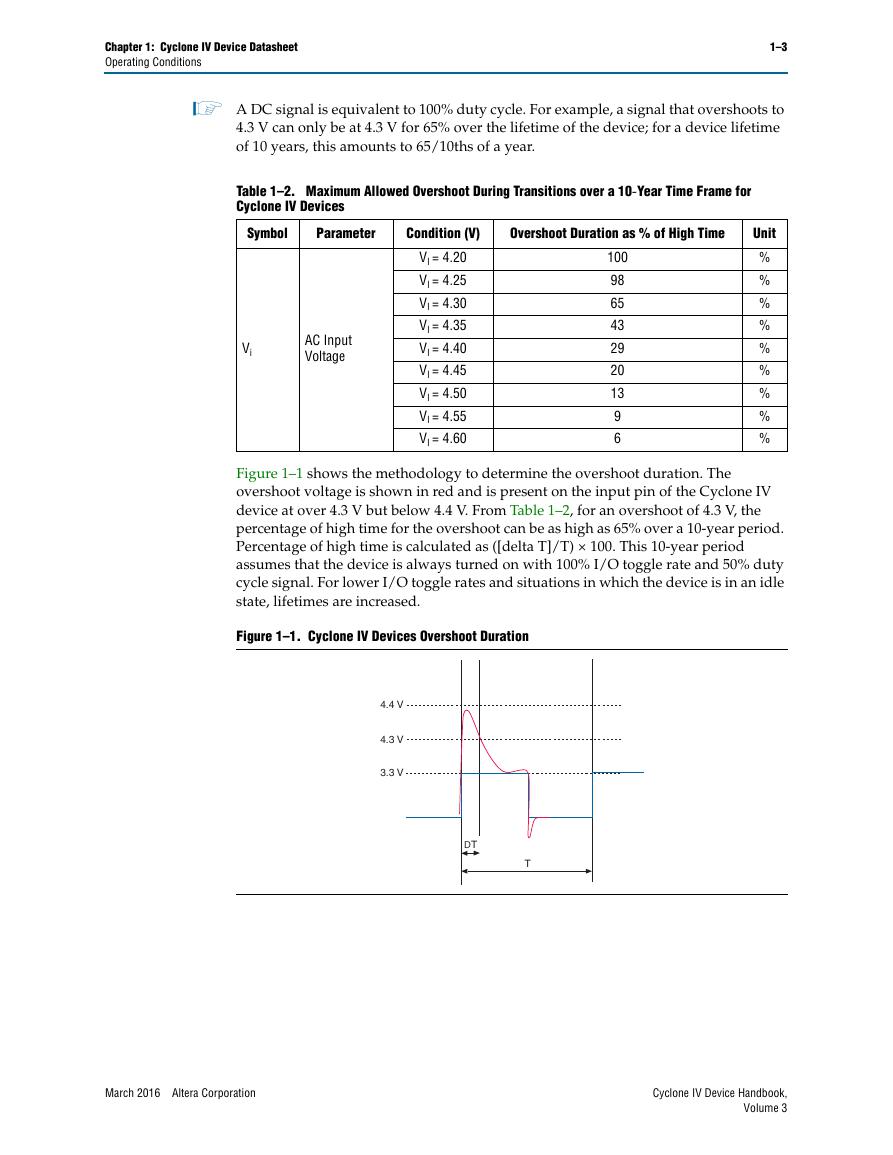

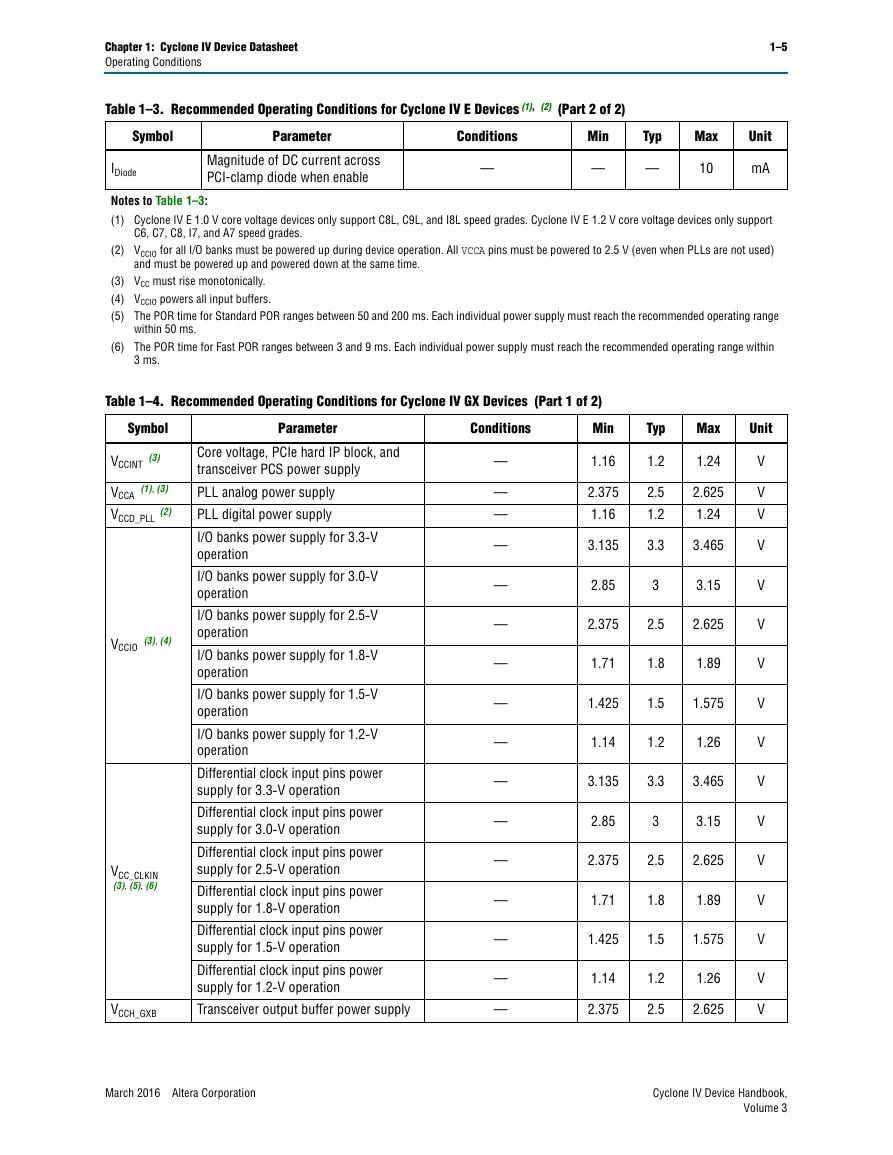
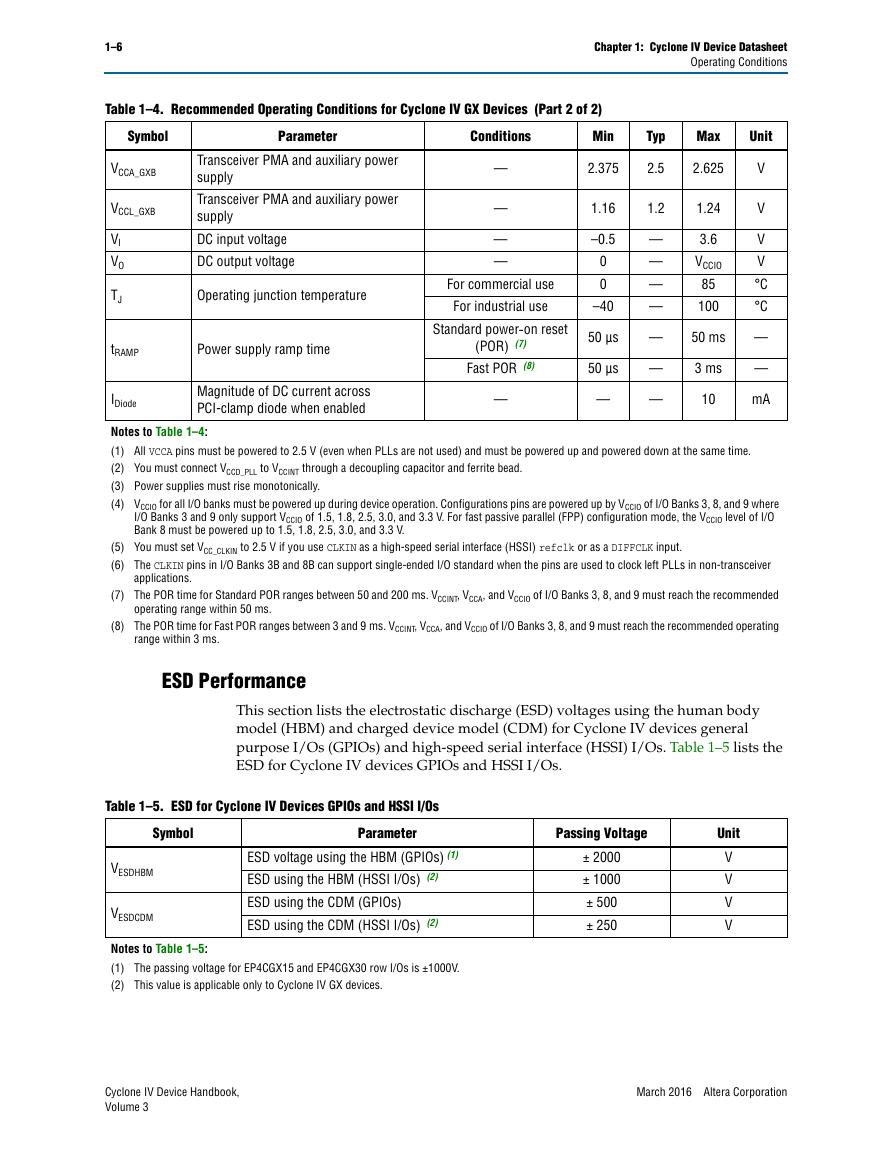

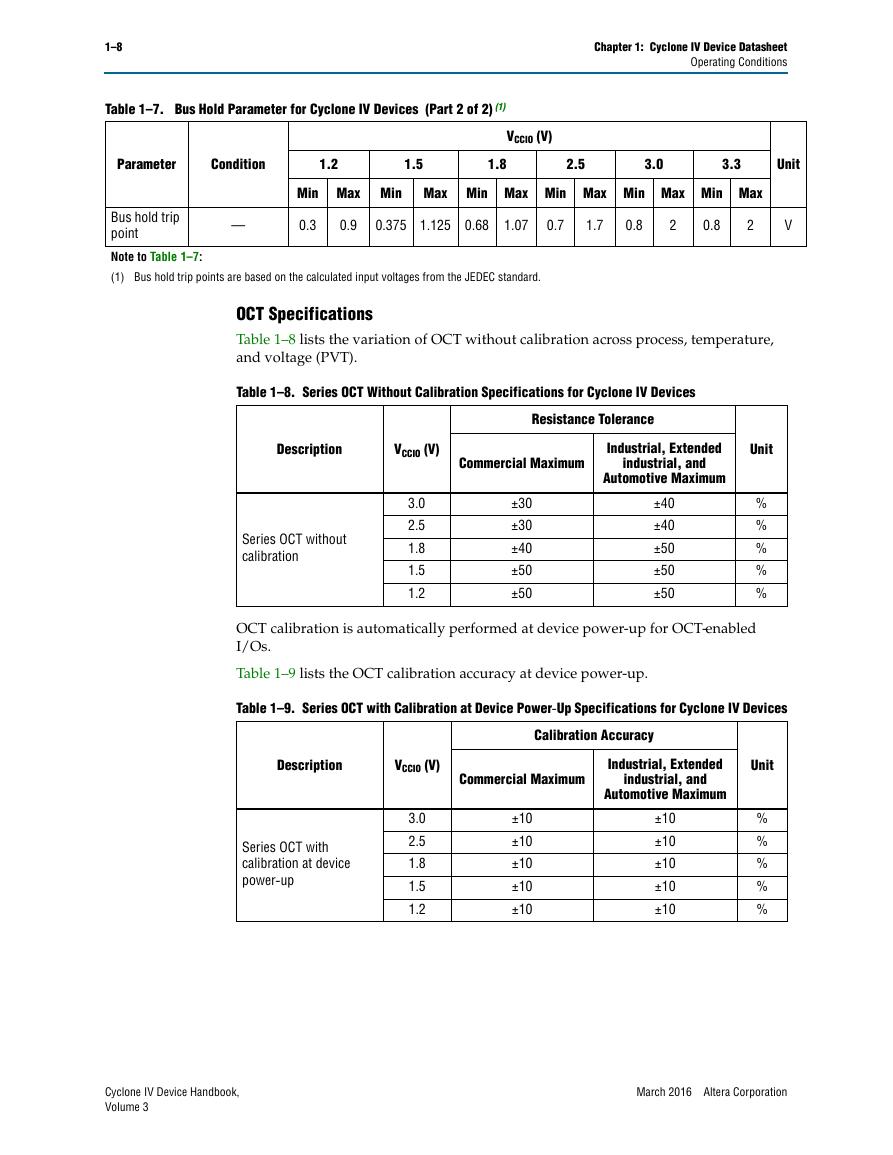








 V2版本原理图(Capacitive-Fingerprint-Reader-Schematic_V2).pdf
V2版本原理图(Capacitive-Fingerprint-Reader-Schematic_V2).pdf 摄像头工作原理.doc
摄像头工作原理.doc VL53L0X简要说明(En.FLVL53L00216).pdf
VL53L0X简要说明(En.FLVL53L00216).pdf 原理图(DVK720-Schematic).pdf
原理图(DVK720-Schematic).pdf 原理图(Pico-Clock-Green-Schdoc).pdf
原理图(Pico-Clock-Green-Schdoc).pdf 原理图(RS485-CAN-HAT-B-schematic).pdf
原理图(RS485-CAN-HAT-B-schematic).pdf File:SIM7500_SIM7600_SIM7800 Series_SSL_Application Note_V2.00.pdf
File:SIM7500_SIM7600_SIM7800 Series_SSL_Application Note_V2.00.pdf ADS1263(Ads1262).pdf
ADS1263(Ads1262).pdf 原理图(Open429Z-D-Schematic).pdf
原理图(Open429Z-D-Schematic).pdf 用户手册(Capacitive_Fingerprint_Reader_User_Manual_CN).pdf
用户手册(Capacitive_Fingerprint_Reader_User_Manual_CN).pdf CY7C68013A(英文版)(CY7C68013A).pdf
CY7C68013A(英文版)(CY7C68013A).pdf TechnicalReference_Dem.pdf
TechnicalReference_Dem.pdf